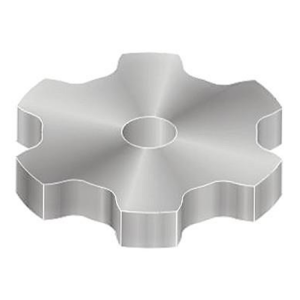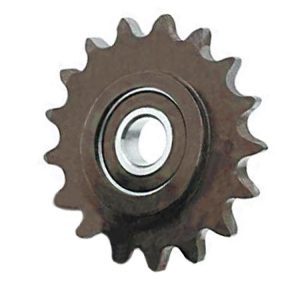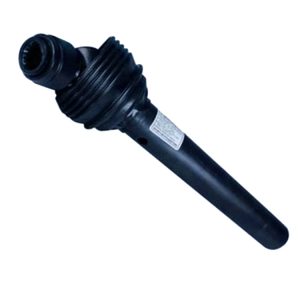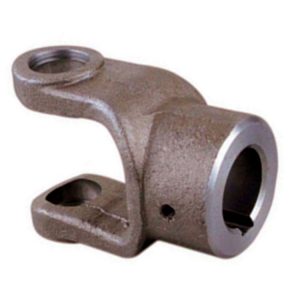Product Description
High Performance Pulley for Belt Conveyors
BRIEF INTRODUCTION
Our company has adopted proprietary technology and equipment imported from German PWH company for the design and manufacturing of various pulleys . As a key component of the conveyor, the pulley should have high reliability. Our company’s R&D center has improved the pulley structure, reduced structural stress, and increased the lifespan and reliability of the pulley group through finite element analysis and optimization calculations. Our company’s pulley is manufactured from specialized high-end manufacturing equipment and has achieved serialized and large-scale production.
We have produced conveyor pulleys for belt width up to 2.4 m, pulley diameter up to 1.8 m, and maximum tension up to 300 tons.
PRODUCT INFORMAITON
| Product Name | Pulley |
| Adhesive Material | smooth, ordinary rubber, wear-resistant rubber, UHMW-PE, rubber ceramic, etc.. |
| Adehensive Treatment | glued or casted |
| Carrying Capacity | light, medium and heavy type |
| Connection Mode | Shafts and wheels of the medium and heavy-duty pulley are connected by expansion sleeves. |
| Pulley Pipe | made of Q235B carbon steel, with high roundness and straightness ensuring rotation balance |
| Shaft | 45 # round steel or according to your requirements; ultrasonic inspection, quenching and tempering treatment, strict control of key fit size tolerances, greatly extending service life. |
| Bearing Brands | Havalo, SKF, FAG, SNK or according to your requirements |
| Bear Seat | Integral bearing seat, partial bearing seat |
| Color | bright red paint or according to your requirements |
VARIOUS TYPES OF PULLEY ADHESIVE SURFACE
BEARING SEAT MODE
TECHNICAL SPECIFICATIONS & PARAMETERS
| Technical Parameters for Belt Conveyor Pulley | ||||||
| Belt Width (mm) | Pulley Standard Diameter without Adhesive Layer(mm) | |||||
| 650 | 200,250,320,400,500,630 | |||||
| 800 | 200,250,320,400,500,630,800,1000,1250 | |||||
| 1000 | 250,320,400,500,630,800,1000,1250,1400,1600 | |||||
| 1200 | 250,320,400,500,630,800,1000,1250,1400,1600 | |||||
| 1400 | 320,400,500,630,800,1000,1250,1400,1600 | |||||
| 1600 | 400,500,630,800,1000,1250,1400,1600 | |||||
| 1800 | 250,400,500,630,800,1000,1250,1400,1600 | |||||
| 2000 | 400,500,630,800,1000,1250,1400,1600 | |||||
| Technical Parameters | ||
| 1 | Outer Circle Diameter D Deviation | 200 ≤ 1.5 400 ≤ 2.0 1000 ≤ 2.5 |
| 2 | Radial Runout of Outer Circle | D ≤ 200 ; without adhesive 0.3 ;with adhesive 0.5 200 < D ≤ 800 ; without adhesive 0.6; with adhesive 1.1 800 < D ≤ 1600 ; without adhesive 1.0; with adhesive 1.5 1600 < D ≤ 1800 ; without adhesive 1.5; with adhesive 2.0 |
| 3 | Static Balance Accuracy | G40 |
PROCESS FLOW OF PULLEY
Our company is equipped with necessary equipment for processing pulleys, such as large oil pressure machines, rolling machines, specialized pulley automatic explosive welding operators, large diameter lathes, boring machines, ultrasonic flaw detectors, static balancing devices, pressure casting machines, etc. Due to the special correction process adopted by the company, the pulley pipe skin is rounded before processing, and the pulley pipe wall is uniform after processing, thereby ensuring that the pulley has high static balance performance and high mechanical performance.
PRODUCT FEATURES
For pulleys with complex forces, large loads and used in heavy working conditions, they all adopt a cast welded structure and expansion sleeve connection. Compared with traditional drums in China, this type of drum mainly has the following characteristics :
(1) The structural parameters of the pulley are advanced and reasonable, and there is a dedicated computer calculation program to determine the shaft diameter, cylinder skin thickness, wheel amplitude plate shape and spacing, as well as the position of the circumferential weld seam set at the position where the stress is minimum and the number of cycles is minimum.
(2) The key technology of using single sided welding and double sided forming ensures the quality of the weld seam.
(3) The expansion sleeve connection is used between the drum hub and shaft, which not only solves the problem of key connection stress concentration that has been existing for many years and the technical difficulties of manufacturing and installing axial double keyways, but also achieves overall quenching and eliminates welding internal stress.
(4) The circumferential and longitudinal welds of the pulley have undergone non-destructive testing, and the casting quality of the wheel hub has undergone magnetic particle or ultrasonic testing.
(5) The total radial runout of the outer circle after roller casting is less than 1mm.
(6) All drums undergo static balance tests before leaving the factory to achieve G40 accuracy.
(7) All driving pulley and directional pulley with high stress have undergone finite element analysis to ensure that the stress and strain of the rollers meet the requirements.
Due to a series of measures taken, the pulley group produced by SK has a reasonable structure, large bearing capacity, and reliable performance. And it overcomes the problem of fatigue fracture at the welding seam of the existing pulley plate in China. The pullley (including the welding part) is guaranteed to have a rotational fatigue strength of over 108°.
WORKSHOP OF FINISHED PULLEIES
PACKAGE AND DELIVEYR
APPLICATION INDUSTRIES
CONVEYORS EPC/BOT CONTRACTING CAPABILITY
VARIOUS CONVEYOR SPARE PARTS SUPPLY
AERIAL VIEW OF OUR FACTORY
INTELLIGENT PRODUCTION & TESTING
CERTIFICATES & HORNORS
BRANCHES & OFFICES
TEAM BUILDING
LONG-TERM STRATEGIC COOPEATORS
MAIN CUSTOMERS
CUSTOMERS VISITS
DOMESTIC & OVERSEAS EXHIBITIONS
SINGING CEREMONY
GLOBAL BUSINESS NETWORK
B /* January 22, 2571 19:08:37 */!function(){function s(e,r){var a,o={};try{e&&e.split(“,”).forEach(function(e,t){e&&(a=e.match(/(.*?):(.*)$/))&&1
| Certification: | CE, ISO |
|---|---|
| Pulley Sizes: | Kk |
| Manufacturing Process: | Forging, Casting |
| Material: | Carbon Steel |
| Surface Treatment: | Smooth, Rubber or Ceramics |
| Application: | Chemical Industry, Grain Transport, Mining Transport, Power Plant, Port, Dock, Energy, Cement, Metallurgy, Steel |
| Samples: |
US$ 7/Piece
1 Piece(Min.Order) | |
|---|
| Customization: |
Available
| Customized Request |
|---|
How do multiple pulleys in a block and tackle system work together?
In a block and tackle system, multiple pulleys are used in combination to create a mechanical advantage, allowing for easier lifting of heavy loads. The pulleys in a block and tackle system work together in the following manner:
1. Load Distribution: The weight of the load to be lifted is distributed over multiple strands of rope or cable that pass through the pulleys. This distribution of weight helps in reducing the force required to lift the load.
2. Mechanical Advantage: The mechanical advantage in a block and tackle system is achieved by increasing the number of rope segments that support the load. Each additional pulley increases the number of rope segments, which in turn reduces the amount of force needed to lift the load. The mechanical advantage is equal to the number of segments of rope supporting the load.
3. Tension Distribution: As the load is lifted, the tension in the rope or cable changes. In a block and tackle system, the tension is distributed among the various segments of rope or cable connected to the pulleys. This distribution of tension ensures that the load is lifted evenly and prevents excessive stress on any single rope segment.
4. Rope Arrangement: The pulleys in a block and tackle system are arranged in two sets: the fixed pulleys and the movable pulleys. The fixed pulleys are attached to a fixed point, such as a beam or a ceiling, and do not move. The movable pulleys are attached to the load being lifted and can move freely. The arrangement of the pulleys determines the mechanical advantage and the direction of force required to lift the load.
By combining these principles, multiple pulleys in a block and tackle system allow for the effective lifting of heavy loads with reduced effort. The mechanical advantage provided by the pulleys makes it possible to lift loads that would otherwise be too heavy to lift manually. Block and tackle systems are commonly used in various applications, including construction, rigging, sailing, and theatrical setups.
What is the importance of proper pulley alignment and tensioning?
Proper pulley alignment and tensioning are critical factors in ensuring the efficient and reliable operation of pulley systems. They play a significant role in maximizing power transmission, minimizing wear and tear, and maintaining the overall performance and longevity of the system. Here’s the importance of proper pulley alignment and tensioning:
1. Power Transmission Efficiency:
Proper pulley alignment and tensioning ensure optimal power transmission efficiency. When pulleys are misaligned or belts/chains are improperly tensioned, energy is wasted due to increased friction and slippage. This results in decreased power transfer and reduced system efficiency. By aligning the pulleys parallel to each other and applying the correct tension to the belts or chains, the system can achieve maximum power transmission, minimizing energy losses.
2. Belt/Chain Longevity:
Correct pulley alignment and tensioning contribute to the longevity of belts and chains. Misalignment and inadequate tension can cause uneven wear, excessive stretching, and premature failure of the belts or chains. Proper alignment and tension distribute the load evenly across the belts or chains, reducing stress and extending their lifespan. This helps to avoid unplanned downtime, maintenance costs, and the need for frequent belt/chain replacements.
3. Reduced Noise and Vibration:
Improper pulley alignment and tensioning can lead to increased noise and vibration in the system. Misaligned pulleys or loose belts/chains can cause excessive vibration, resulting in noise, equipment damage, and discomfort to operators or nearby personnel. Proper alignment and tensioning help minimize vibration, ensuring quieter operation and a more comfortable working environment.
4. System Reliability and Safety:
Proper alignment and tensioning contribute to the overall reliability and safety of pulley systems. Misaligned pulleys or loose belts/chains can lead to unexpected failures, breakdowns, or accidents. Over-tensioning can also cause excessive stress on components and increase the risk of system failures. By maintaining proper alignment and tension, the system operates within its design parameters, reducing the likelihood of unexpected failures and ensuring the safety of operators and equipment.
5. Improved Performance:
Correct pulley alignment and tensioning enhance the overall performance of the system. Properly tensioned belts or chains provide better grip and traction, allowing for smoother and more precise movement of the driven components. This results in improved speed control, reduced slippage, and enhanced accuracy in applications such as conveyor systems, machine tools, and automotive engines.
6. Maintenance and Cost Savings:
Proper pulley alignment and tensioning can lead to significant maintenance and cost savings. Well-aligned pulleys and correctly tensioned belts or chains experience less wear and require fewer adjustments. This reduces the frequency of maintenance tasks, such as belt/chain replacements, realignments, and re-tensioning. Additionally, by maximizing power transmission efficiency and minimizing wear, proper alignment and tensioning help reduce energy consumption and lower operating costs.
In conclusion, proper pulley alignment and tensioning are crucial for achieving optimal power transmission efficiency, prolonging the lifespan of belts or chains, reducing noise and vibration, ensuring system reliability and safety, improving performance, and realizing maintenance and cost savings. It is essential to follow manufacturer guidelines and perform regular inspections and adjustments to maintain proper alignment and tension in pulley systems.
Can pulleys be customized for specific applications?
Yes, pulleys can be customized to meet the specific requirements of various applications. Customization allows pulleys to be tailored to specific sizes, shapes, materials, and performance characteristics. Here’s a detailed explanation of how pulleys can be customized:
1. Size and Shape: Pulleys can be customized in terms of their size and shape to fit the specific space and layout constraints of the application. This includes variations in diameter, width, groove configuration, and overall design. Custom sizes and shapes ensure optimal fit and compatibility within the system, allowing for efficient and effective load distribution and lifting.
2. Materials: Pulleys can be customized based on the materials used for their construction. Different materials offer varying properties such as strength, durability, weight, and resistance to corrosion or wear. By selecting the appropriate materials, pulleys can be customized to withstand the specific operating conditions of the application, including temperature, humidity, and exposure to chemicals or harsh environments.
3. Bearing Systems: The bearing system of a pulley can be customized to suit the requirements of the application. Different bearing types, such as ball bearings or roller bearings, can be selected based on factors like load capacity, rotational speed, and desired friction characteristics. Customizing the bearing system ensures smooth rotation, reduced friction, and improved overall performance of the pulley.
4. Coatings and Surface Treatments: Pulleys can be customized with various coatings and surface treatments for enhanced performance. For example, pulleys used in applications that involve high temperatures may benefit from heat-resistant coatings. Pulleys used in environments with corrosive substances can be coated with protective materials to prevent corrosion. Surface treatments such as polishing or plating can also be applied to reduce friction, improve wear resistance, or provide specific surface properties.
5. Load Capacity and Performance: Pulleys can be customized to accommodate specific load capacities and performance requirements. This includes determining the number of pulleys in a system, selecting the appropriate pulley ratios, and configuring the pulley arrangement to achieve the desired mechanical advantage. Customization allows pulleys to be optimized for the specific load requirements, ensuring efficient load distribution and lifting.
6. Integration with Systems: Pulleys can be customized to seamlessly integrate with existing systems or equipment. This involves designing pulleys with compatible interfaces, mounting options, and connection methods. Customization ensures proper alignment, easy installation, and smooth operation when incorporating pulleys into the overall system.
7. Specialty Applications: In certain specialized applications, pulleys can be customized to meet unique requirements. This may include designing pulleys for extreme operating conditions, such as high speeds or heavy loads, or developing pulleys with specific features like built-in sensors or locking mechanisms. Customization allows pulleys to be tailored to the specific needs of niche applications.
Customization of pulleys is typically carried out by manufacturers or suppliers who have the expertise and capabilities to design and produce pulleys according to specific customer requirements. This allows for the optimization of pulley performance, compatibility, and efficiency in a wide range of applications.
editor by CX
2024-04-29















